
Columbia River Salmon Recovery
For the better part of three decades, the U.S. Army Corps of Engineers has thumbed its nose at the law, the courts, and the public as it has failed time and time again to develop a plan to protect and recover federally listed salmon from the impacts of the federal hydropower system (the dams). The Corps has been sued and lost five times during that period for its inadequate plans. Instead of addressing the dams, the Corps has focused resources on relentless persecution of natural predators of salmon such as Double-crested Cormorants and sea lions.

The science clearly shows that salmon recovery is dependent on two things: removal of four obsolete dams on the Snake River and improving flows over the dams on the Columbia. In late February, the Corps released another draft plan that failed to address these concerns and provide the public with an outrageously short 45-day comment period—a timeline they stubbornly stuck to even as the COVID crisis exploded in its midst. Bird Alliance of Oregon is proud to be part of a coalition of groups demanding real solutions to this decades-old crisis, but we have no confidence that the Corps will step up. In the coming months we will be working to have the Northwest Congressional Delegation step in and develop solutions where the Corps has repeatedly failed.
I-5 Rose Quarter Freeway Expansion
Nothing is more representative of our failure to address global climate change than our approach to transportation infrastructure which remains mired in 1950s style dogma. From its inception, the I-5 project has been a boondoggle in search of a rationale. The data clearly shows that the project will not address congestion and is extremely low on the priority list in terms of safety. Yet ODOT has continued to advance this project for more than a decade. A glimmer of hope appeared in April 2019 when an overwhelming array of community stakeholders demanded that ODOT do a comprehensive environmental impact statement to assess the project and explore alternatives.

Politicians who had sat on their hands at Metro, City of Portland, and in the governor’s office appeared to heed the call and demanded more review. Unfortunately in April, even as costs ballooned from $500 million to more than $800 million and the COVID-19 crisis exploded, ODOT decided to advance the project without an EIS, and local political and state leadership mostly evaporated. However, the battle is far from over—there are many opportunities ahead to reform or abandon this boondoggle.
Columbia River Levee System
For a century, the U.S. Army Corps of Engineers has built levee systems with reckless disregard for the natural functioning of ecosystems. The arrogance of the Corps’ approach has manifested itself in a series of tragic levee failures in recent decades as water finds a way. Nobody questions the need to keep our communities safe from flooding, but it is long past time for the Corps to develop a paradigm that integrates rather than subjugates the environment and environmental justice. The modernization of the Columbia River Levee system, which provides flood protection for more than 24,000 acres of historic Columbia River floodplain, is just such an opportunity.

In January, the Corps released a draft plan for modernizing the levee system that ignored environmental impacts and environmental justice issues, flagrantly underestimated costs, failed to fully address existing deficiencies in the levee system, and gave the public a woefully short 45 days to comment: in short, business as usual. Despite strong condemnation from stakeholders including conservation organizations, environmental justice organizations, neighborhood groups, and the Yakama Nation Fisheries, local jurisdictions signaled their support for the Corps’ plan, and in April, as the COVID crisis exploded, the Corps advanced their plan for final approval in Washington, D.C. In the coming year, the fatal flaws in this plan will only become more apparent. So too, will the opposition.
What do these three projects have in common?
Each one perpetuates exactly the type of anachronistic policies and practices that have precipitated the current environmental crisis. Each one made a mockery of the public review process. In each instance local jurisdictions with stated commitment to environmental health and justice rolled over and played dead. And in each case, the lead agencies chose to hit the accelerator, even as our communities struggled to cope with the COVID-19 crisis.
Under ordinary circumstances, Bird Alliance of Oregon practices full-contact conservation. It is a work of hearings, committees, meetings, events, protests, research, and field work. However, we have rapidly made the transition to a fully digitized universe and are excited by how our activists have risen to the occasion. We are seeing a remarkable response to action alerts, and our activists have flooded recent online hearings. We have known for a long time that fundamental change is necessary. We can now see that it is also possible. Your voice is more important than ever in the age of COVID.




